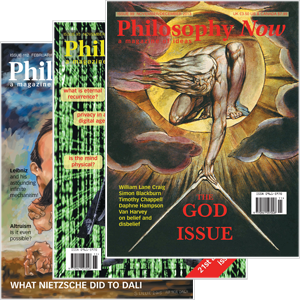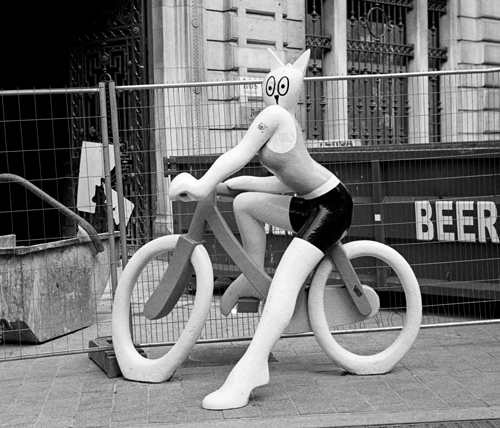
Your complimentary articles
You’ve read one of your four complimentary articles for this month.
You can read four articles free per month. To have complete access to the thousands of philosophy articles on this site, please
Street Philosopher
Bicycling in Brussels
Seán Moran suspects simple stereotypes.
A bicycle, a cartoon character, and beer: this could only be Belgium. And so it is. We are in the land of champion cyclist Eddie Merckx, of Hergé’s Adventures of Tintin, and of twenty-one different types of beer in every bar. To complete the picture, all my photograph needs is an elegant Brussels eurocrat holding a box of Belgian chocolates in one hand and a René Magritte painting in the other, a Hercule Poirot story poking out of her Delvaux handbag. But these are stereotypes. Belgian culture is much richer and more varied than this. Even if we add singer Jacques Brel, photographer Martine Franck, and musical instrument inventor Adolphe Sax, we are still no closer to capturing Belgian-ness.

Photo © Seán Moran 2021
My photograph doesn’t do full justice to the subject of Belgium either: it is merely a partial depiction. In his famous painting The Treachery of Images (1929), the surrealist artist Magritte featured a tobacco pipe. Below it, he painted the paradoxical statement ‘ Ceci n’est pas une pipe’ (‘This is not a pipe’). In one sense, he is correct. What we see is a two-dimensional depiction of a pipe, not an actual 3D pipe with a particular heft and warmth in the hand, an individual aroma, and a unique history. So too with my photograph. It’s a snapshot of Belgium – a vain attempt to sum up a whole country in a single two-dimensional image. As Magritte might have said, ‘ Ceci n’est pas la Belgique’.
In my defence, I try to depict accurately what I see on the street. My camera is a vintage Leica, using old-fashioned film rather than a digital sensor, so the potential for dishonest photography is reduced (though in Soviet-era Russia, using similar technology they laboriously managed to erase ‘purged’ politicians from photographs featuring Stalin). The lens gives a natural perspective, and I don’t Photoshop the images. Even so, the camera can lie. Photographs can be treacherous.
Take the word ‘Beer’ in the image. Beer is part of mainstream Belgian culture, with a multitude of traditions – each brew is served in its own specially-shaped glass, for instance – and its importance seems to be acknowledged in my photograph. However, you can’t always believe what you see. The word was painted on a builder’s skip (dumpster), and is in fact the name of the waste-disposal company: Beermann, Beerling, or possibly Beerwinkel – I can’t remember which. It only became ‘Beer’ when I stood in the right place on the street to crop out the second half of the word. Thus without resorting to Photoshop manipulation or Stalinist airbrushing, my selective framing has created a misleading impression. The epistemic value of the photograph has been compromised by the way it’s framed. (Epistemology is the branch of philosophy that deals with the nature of knowledge.) Viewers of the photograph may be hoping to acquire some knowledge of this little corner of Belgium, but they’re not fully in ‘cognitive contact with reality’, to use the American philosopher Linda Zagzebski’s definition of knowledge. The image has reinterpreted reality, and subtly dislocated the viewers’ cognitive contact. So it would be unfair to use the photograph in legal proceedings, where the literal facts of the matter are at stake. It should not be given in evidence to prosecute someone for selling beer without a licence.
The image doesn’t tell us much about cats either. The representational chain goes like this: 3D living cat becomes 2D cartoon cat becomes 3D sculpture of a cartoon cat becomes 2D photograph of a sculpture of a cartoon cat. The end product is so far removed from the subject it supposedly depicts that we can’t trust it much for epistemic purposes. It would have zero value for a veterinarian’s course in feline physiology, for example.
The bike is similarly distorted. Many bottles of the finest Belgian beer (each poured into a differently shaped glass) would be needed in order to convince a Brussels bicycle thief that he could actually ride the thing away.
But neither I nor the cat’s sculptor, Alain Séchas, would claim that we’re attempting to depict straightforward reality (if there even is such a thing). We have both simplified aspects of a complex world so that they can be grasped instantly. Alain’s efforts took a significant amount of time, and reportedly cost the city of Brussels €100,000. My work took a mere 1/250 second.
Limited Bandwidths & Straw Men
Simplifications have value, because they take account of humans’ limited cognitive bandwidth. In our fast-paced world, in both the real and virtual domains, we often ignore anything unduly complex because it’s too demanding of our powers of concentration. Of course Philosophy Now readers are well endowed with such powers, being able and willing to read and consider the nuanced and intricate ideas that appear in the magazine. Even smart people appreciate punchy messages, though. Carefully-honed signals, such as powerful political or advertising slogans and images, cut through the background noise and have an impact that a lengthy disquisition would not.
But over-simplification, although seductive, is dangerous. It can lead to a cartoonish interpretation of someone’s pronouncements, a verbal caricature of their actual views. When I give street performances in Paris on my flute, I often play beside an eccentric fellow artist called Freddie, a professional caricaturist. He can quickly reduce a customer’s image to a few bold strokes. Freddie is also skilled at identifying an easily-recognisable feature of his subject and exaggerating it for comic effect. And even though we work outside Notre Dame Cathedral, he will instead relocate the image to the Eiffel Tower – about 4km away – because that says ‘Paris’ more instantly and simply.
Freddie’s three techniques – simplification, exaggeration, and outright fabrication – are appreciated by his clients. The results are benign, entertaining, and profitable. But in philosophy, it is considered improper to represent someone’s views in such ways. If we did this, we’d be justly accused of constructing a ‘Straw Man’. After misrepresenting our interlocutor by simplifying, exaggerating, or fabricating their position, we now only have to knock down an insubstantial scarecrow version of their thinking – a Straw Man – instead of tackling their actual statements. That’s unfair.
Politicians are fond of this move. They twist, or even invent, their opponent’s words to make them an easier target, then proceed to demolish this caricature of their position. In extreme cases, demagogues demonise their opponents as the source of wholly wrongheaded, evil views, while sanctifying themselves as the only fount of wisdom. We don’t have to look far to see world leaders, past and present, indulging in these sly manoeuvres.
But what exactly constitutes a Straw Man is not a straightforward matter. As George Y. Bizer et al point out, a simple principle such as ‘a misquotation is a Straw Man’ is not always correct, because “misquotations can also be justified paraphrases of what has been said” (Social Influence, 2009). Contrariwise, an accurate direct quote can be a Straw Man if it is taken out of context, like my ‘Beer’ sign. (An even more striking example is the accurate Biblical quotation “there is no God.” Psalm 14 actually says this – but it’s only making an atheist claim if we conveniently edit out the preceding words, “The fool says in his heart…”)
The Polish philosopher Marcin Lewinski identifies two key properties of the Straw Man fallacy as its ‘‘unreasonableness and treacherousness’’ (Argumentation, 2011). This seems correct. It echoes Magritte’s Treachery of Images, and can also include treachery towards a fellow human being (by way of ‘bearing false witness’ against them, in further Biblical language). We might generally term this ‘epistemic treachery’.
Decent folks shouldn’t be doing this sort of thing. But as we know, some politicians and others have no reservations about maliciously misrepresenting their opponents. We should be alert to their shenanigans, because “the Straw Man may only be effective among people who lack the motivation to carefully scrutinize a persuasive message” (Social Influence). But pretty much all of us sometimes lack the motivation to scrutinize messages carefully, and even when this task is performed for us by fact-checkers, such scrutiny can easily be written off as wrong-headed, or itself malicious.
Moral Truth
The opposite of treachery is loyalty. Our reporting of the words of others should be loyal to their intended meaning. If we’re going to disagree with them, it ought to be on the basis of what they actually mean, rather than on the basis of an easy-to-dismiss, cartoon version of their views. In the words of American philosopher Donald Davidson, we must show “Charity in interpreting the words and thoughts of others” (The Essential Davidson, 2006, p.163). This ‘principle of charity’ is not meant to make us behave in a kindly way towards people, but is rather, an essential epistemic technique for extracting the real meaning of what they say. To understand people, we should put the best possible interpretation on their words: “just as we must maximize agreement, or risk not making sense of what [he] is talking about, so we must maximize the self-consistency we attribute to him, on pain of not understanding him.”
I would go further. There is a moral as well as an epistemic dimension to interpreting and rephrasing what others say. Misrepresentation is uncharitable. Deliberately falsifying their views insults the other person’s dignity, and also deprives us of an opportunity to understand the world better – to forge a firmer cognitive contact with reality. So we should not raise a Straw Man by distorting our interlocutor’s words, but rather help them to express their opinions in the most luminous way possible.
Viewed in a charitable light, perhaps my photograph does encapsulate a little bit of Belgitude, and the sculpted cat is not a Straw Man but reveals something worth knowing about felinity. The bigger message, though, is that simplistic stereotypes of political and other stances are undesirable. There is probably some merit in the views of their opponents, so politicians, and philosophers, should bring this out in the most charitable way they can. That would really put the cat among the pigeons.
© Dr Seán Moran 2021
Seán Moran teaches postgraduate students in Ireland, and is professor of philosophy at one of the oldest universities in the Punjab.









